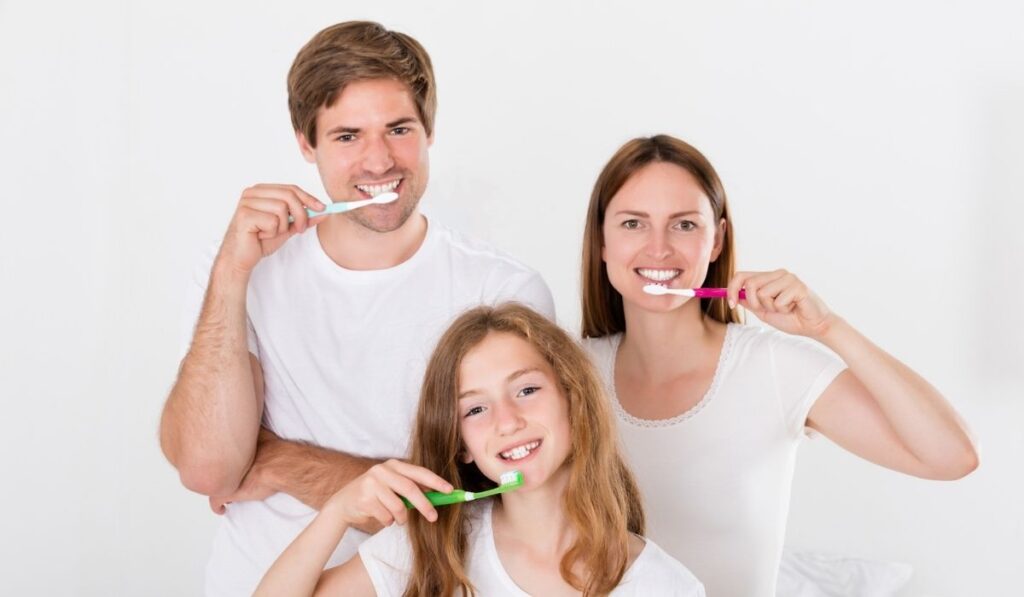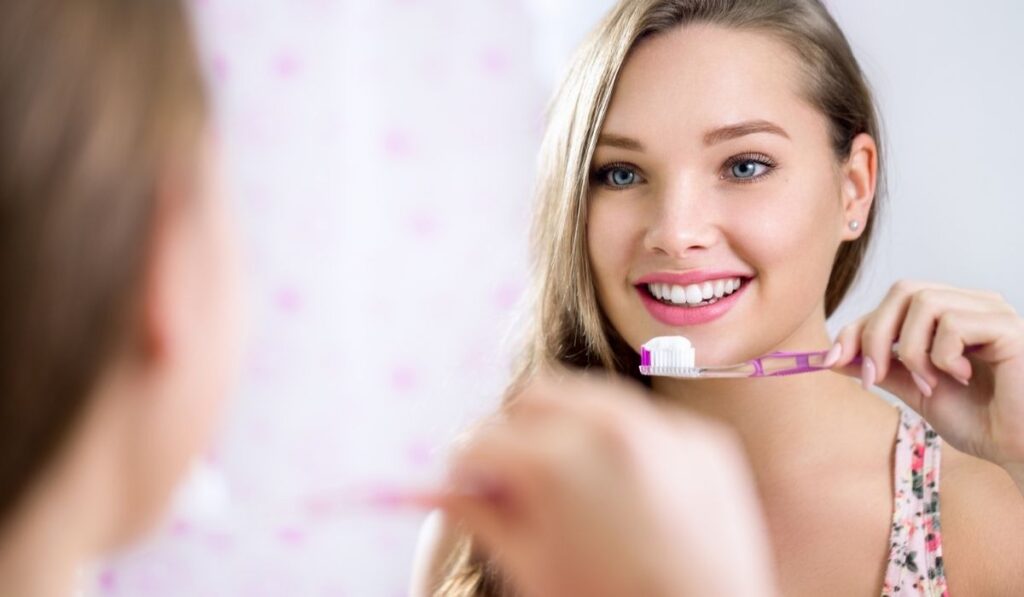As you age, your teeth may gradually change color. This changes occurs because tooth dentin, which lies underneath the outer enamel and is more yellowish in color, becomes more visible as the enamel wears away. So what can you do to whiten your teeth quickly?
You can quickly whiten your teeth using different methods such as brushing properly, using baking soda or hydrogen peroxide, and trying at-home whitening strips or whitening procedure at the dentist. Be cautious when using whitening products because they can cause tooth sensitivity if misused.
Continuously exposing your teeth to whitening products for an extended period or using a product that isn’t approved by the American Dental Association (ADA) could cause damage or sensitivity, so you should be very careful about how you go about whitening your teeth. Let’s examine the causes of yellow teeth, some ways to get rid of them quickly, and methods that aren’t worth trying.
How to Whiten Your Teeth Quickly

It might be best to select a few treatments and alternate them throughout the week. Here are several ways to whiten your teeth quickly.
1. Brushing Your Teeth
Your first course of action should be brushing your teeth more frequently and in the proper manner.
Brushing immediately after eating acidic food/drinks can cause the acids to eat away more enamel, resulting in erosion. For the best results, brush your teeth for two minutes at a time, at least twice a day. Additionally, ensure you reach every crevice and brush your teeth gently and circularly to protect your gums.
Brushing with a whitening toothpaste like Colgate’s Optic White Toothpaste (on Amazon) has also been shown to help whiten teeth. Whitening toothpaste contains gentle abrasives that safely remove surface stains. Also consider using an electric toothbrush to remove surface stains effectively.
2. Use Baking Soda
Baking soda is mildly abrasive and gently polishes away surface stains on the teeth. Using baking soda also helps fight against bacteria, which means you can use it to prevent tooth decay and reduce plaque.
However, extended use may cause irreversible damage to the tooth structure. Consult your dentist to see if this method is appropriate for you.
3. Use Hydrogen Peroxide
Hydrogen peroxide is a gentle bleach that can whiten yellow teeth. For the best results, brush with a paste of baking soda and hydrogen peroxide for one to two minutes.
Remember only to use this mixture on occasion. Moreover, hydrogen peroxide can increase tooth sensitivity. We do not recommend hydrogen peroxide for people with sensitive teeth, and long-term use should be avoided.
4. Whitening Strips
The hydrogen peroxide in these strips is similar to the bleaching agent used in several professional whitening treatments. Whitening strips have a lower concentration of hydrogen peroxide and don’t stay isolated on the surface of the teeth. To get the best results, use whitening strips with a whitening toothpaste.
Remember that you should strictly adhere to the product’s instructions. Overusing strips can lead to tooth sensitivity. Furthermore, you can only use most whitening strips for two weeks. Start right after your yearly dental exam and cleaning if you want to improve the results.
If you’d like to try whitening strips, we recommend the Crest 3D Whitestrips (on Amazon).
5. In-Office Whitening
This procedure usually takes an hour or an hour and a half and then it’s recommended to continue whitening at home to obtain the desired shade.
The dentist will put a rubber shield or protective gel on your gums before applying a bleaching agent to your teeth. They can also create a custom-fitted tray you can use at home.
What Causes Your Teeth to Look Yellow?
Although yellow teeth are not as severe as other dental problems, they can harm your self-esteem. Fortunately, whitening your teeth is as simple as changing your diet and perfecting your dental hygiene routine. Here are six common causes of yellow teeth.
1. Certain Foods or Drinks
Certain foods and drinks can stain your teeth. Tomatoes in pasta sauce, berries, and curry spices can stain the enamel of your teeth. Surprisingly, even a salad with vinegar dressing can cause discoloration of your teeth. Additionally, consuming drinks like tea, coffee, and wine can also stain your teeth.
2. Smoking or Chewing Tobacco
Your teeth, like your skin, have pores. The nicotine and tar found in tobacco and cigarettes readily absorb into the pores on your teeth, leading to discoloration. Nicotine’s harmful effect on your teeth is another reason to kick the habit.
3. Medication
Taking tetracycline can stain teeth in children under the age of 8 and pregnant women. Also, mouthwashes and rinses containing chlorhexidine can stain teeth. Antihistamines, antipsychotic medications, and blood pressure medications also cause teeth yellowing.
4. Teeth Grinding
Grinding your teeth is a subconscious habit some people develop when stressed. This habit is highly damaging to teeth enamel. Teeth grinding does not cause yellowing itself, but it can expose the second layer of the tooth (the dentin), which is a much yellower structure.
5. Diseases
Diseases that affect the dentin and enamel also make your teeth appear yellow. Specific treatments can also have an impact on tooth color. For instance, chemotherapy can discolor teeth.
6. Trauma
Injury to the teeth can cause teeth yellowing in adults. Trauma also disrupts the formation of enamel in kids whose teeth are developing.
4 Methods That Don’t Actually Whiten Your Teeth

Several teeth whitening methods exist without evidence to verify their safety or effectiveness. Here are four techniques that don’t whiten your teeth and may cause adverse effects. They should be avoided!
1. Acidic Fruits
Some people claim that rubbing lemon, orange, or banana peels on the teeth will whiten them. There’s no evidence to support this.
Furthermore, bear in mind that fruits containing acids, like lemons and oranges, pose a risk to your teeth. When you use these fruits to scrub your teeth, acid can enter your teeth’s pores and wear away the enamel. Enamel is your tooth’s outer coating that protects your teeth from sensitivity and cavities.
2. Activated Charcoal
There isn’t any evidence showing that activated charcoal is safe or effective for your teeth. Furthermore, using abrasive materials on your teeth can make them appear more yellow. Remember that using an abrasive scrub can quickly wear away the enamel.
Moreover, when the enamel begins to wear, the soft and yellow layer underneath your tooth (the dentin) may become exposed.
3. Apple Cider Vinegar
Some may claim using apple cider vinegar can whiten your teeth, but it isn’t recommended to use apple cider vinegar as a form of mouthwash or a way to whiten your smile.
Vinegar is an acid that will erode your teeth at an extremely high rate if used for either purpose. Keep the use of apple cider vinegar at a minimum to help protect your teeth.
4. Turmeric
Some people claim that turmeric paste can restore yellow teeth to their natural white color. However, take this claim with a pinch of salt as there isn’t sufficient research to back it up.
Conclusion
There are several effective and safe methods to whiten your teeth. Most of these treatments work by gently removing surface stains from your teeth.
Generally, most dentists offer stronger whitening treatments for more severe cases. These whitening treatments entail bleaching the teeth.
Keep in mind that professional and ADA-recommended bleaching methods won’t harm your teeth, but they may cause sensitivity.
In conclusion, always consult your dentist about teeth whitening options to determine what’s best for you.


